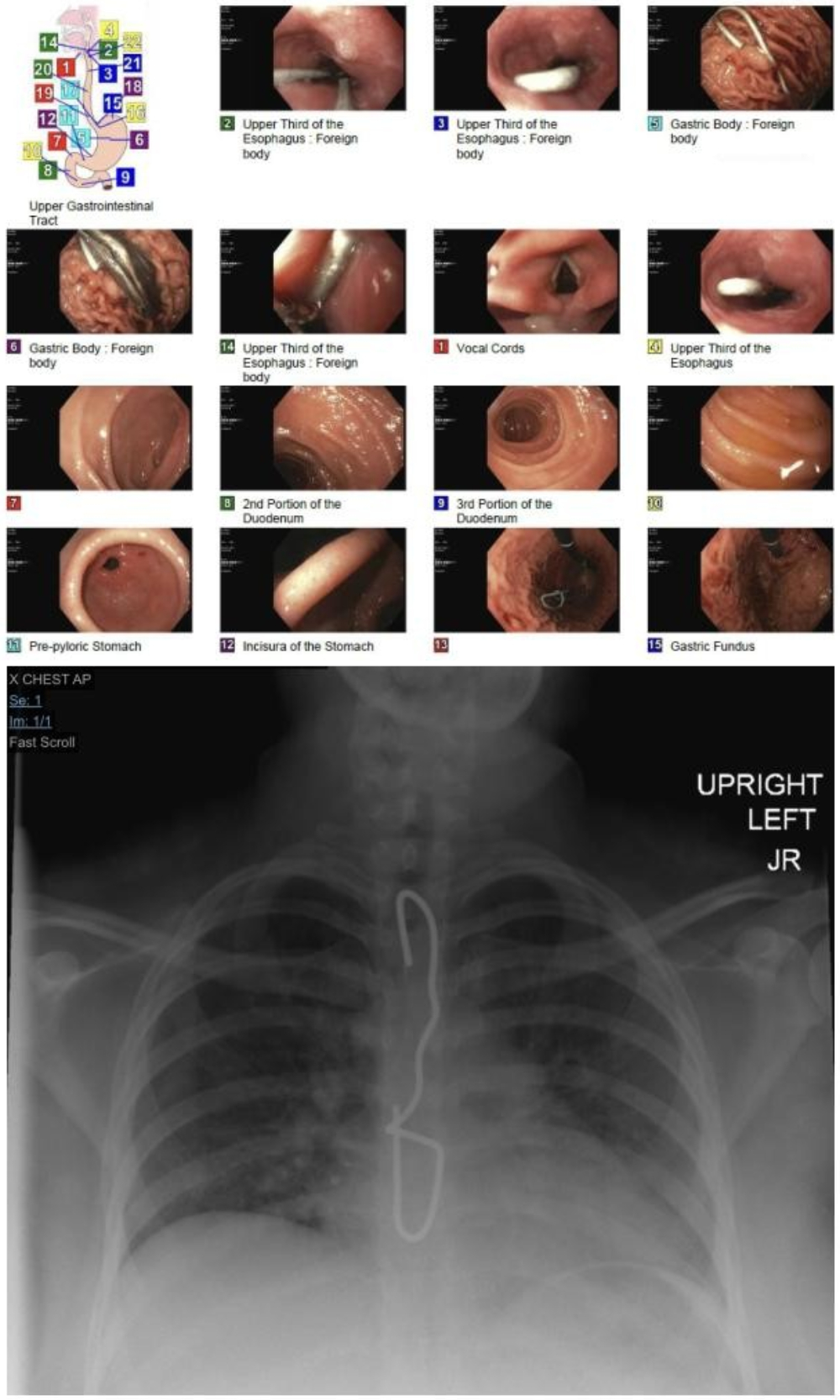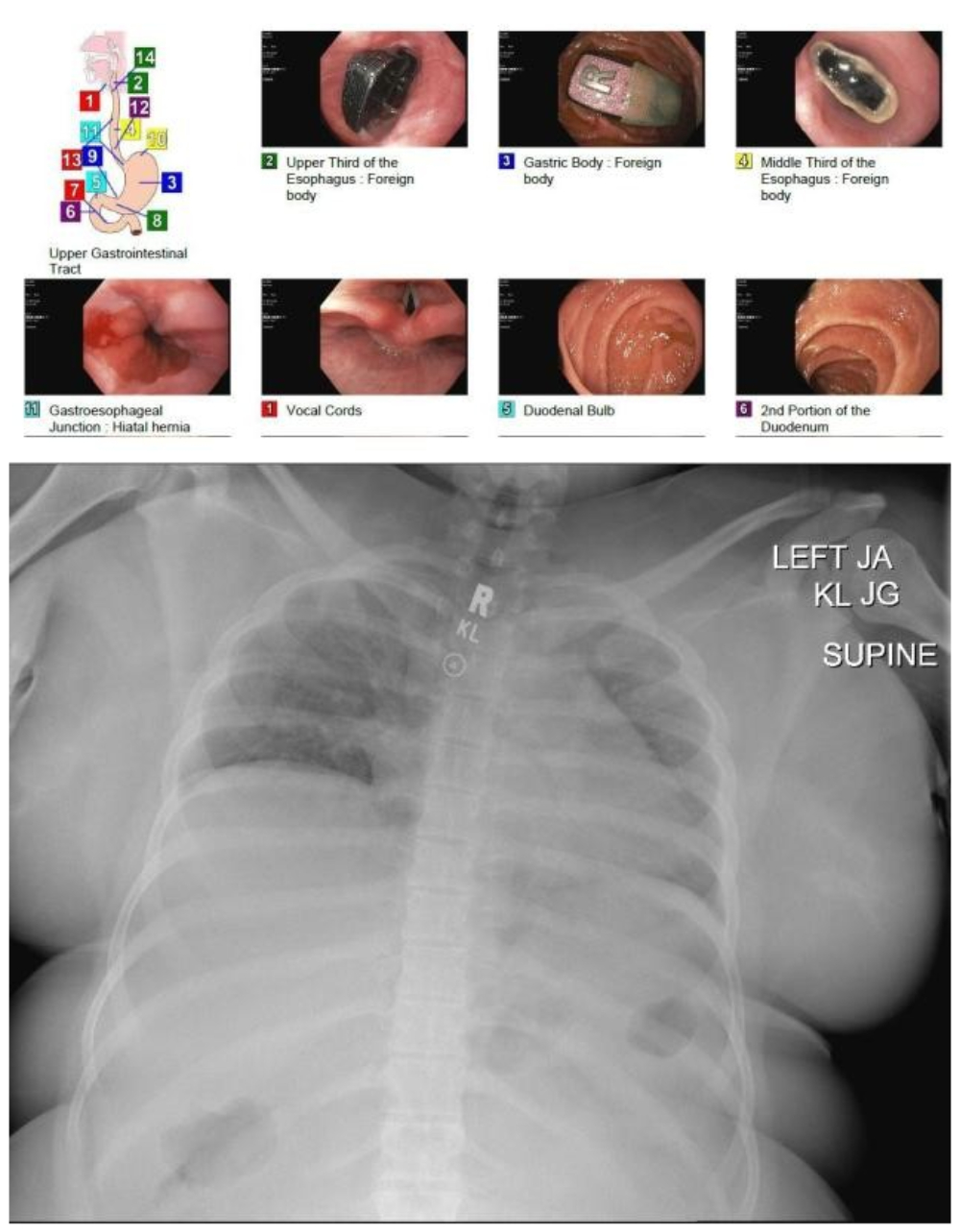Tuesday Poster Session
Category: General Endoscopy
P5149 - Metal, Plastic, and Everything in Between: A Gut-Wrenching Case Study Managing Recurrent Foreign Body Ingestion With Various Endoscopic Techniques
Tuesday, October 28, 2025
10:30 AM - 4:00 PM PDT
Location: Exhibit Hall

Ryan J. Gilbertson, MD, MS, BS (he/him/his)
UHS SoCal MEC
Temecula, CA
Presenting Author(s)
Ryan J. Gilbertson, MD, MS, BS1, Ryan Burd, DO2, John Michael Vincent Coralde, MD2, Kaitlyn Ghassemi, DO1, Indraneel Chakrabarty, MD, MA1
1UHS SoCal MEC, Temecula, CA; 2Southwest Healthcare MEC, Temecula, CA
Introduction: Foreign body (FB) ingestion is common in pediatric populations but also occurs in adults with psychiatric or neurodevelopmental disorders. While most FBs pass spontaneously, 10–20% require endoscopic removal. We present the case of an 18-year-old woman with autism spectrum disorder and PICA who engaged in 17 documented intentional FB ingestion. This report highlights the diagnostic and procedural challenges of managing such cases in a community hospital setting.
Case Description/
Methods: An 18-year-old woman with autism spectrum disorder and PICA was admitted 17 times over six months for intentional foreign body ingestion. Each episode required endoscopic retrieval, with object variation necessitating tailored approaches. In December 2023, a bra wire was removed from the gastric antrum using a grasping device. In March and May 2024, paperclips were retrieved from the esophagus and stomach with snares. Bread ties were removed later in May, followed by a coiled mattress spring located above the upper esophageal sphincter and extracted with forceps. In August, tie-down wires were removed from the gastric antrum and pylorus using a snare. A corkscrew-shaped copper wire in October required multiple repositioning attempts. In November, a radiopaque marker was advanced from the upper esophagus into the stomach and removed with a net. In February 2025, industrial fencing wire lodged at the UES required Trendelenburg positioning, esophageal dilation, and use of a grasping tool. Later that month, a mattress spring was retrieved from the lower esophagus. All objects were removed endoscopically without complications such as perforation or bleeding.
Discussion: Despite multiple high-risk ingestions, the patient had no complications such as perforation, hemorrhage, or infection. Favorable outcomes likely resulted from her young age and consistent inpatient monitoring, enabling timely intervention. Retrieval success depended on matching tools to object type: grasping devices for elongated or flexible metal objects, nets for smooth or mobile items, and snares for irregular but accessible materials. When anatomy posed a barrier, esophageal dilation allowed safe removal. This case highlights the complexity of recurrent intentional ingestion and the need for procedural adaptability, as well as interdisciplinary collaboration across gastroenterology, emergency medicine, radiology, and psychiatry. With timely, coordinated care, even complex ingestion cases can be managed effectively in community hospitals.

Figure: Figure K: Composite image demonstrating a radiomarker initially impacted in the upper esophagus (as seen on chest radiograph), subsequently visualized and retrieved from the gastric body during upper endoscopy using a Roth net.

Figure: Figure M. Industrial fencing wire visualized in the upper esophagus. Retrieval required Trendelenburg positioning, esophageal dilation (54–60 French), and multiple Raptor grasper attempts due to object length and UES impaction.
Disclosures:
Ryan Gilbertson indicated no relevant financial relationships.
Ryan Burd indicated no relevant financial relationships.
John Michael Vincent Coralde indicated no relevant financial relationships.
Kaitlyn Ghassemi indicated no relevant financial relationships.
Indraneel Chakrabarty indicated no relevant financial relationships.
Ryan J. Gilbertson, MD, MS, BS1, Ryan Burd, DO2, John Michael Vincent Coralde, MD2, Kaitlyn Ghassemi, DO1, Indraneel Chakrabarty, MD, MA1. P5149 - Metal, Plastic, and Everything in Between: A Gut-Wrenching Case Study Managing Recurrent Foreign Body Ingestion With Various Endoscopic Techniques, ACG 2025 Annual Scientific Meeting Abstracts. Phoenix, AZ: American College of Gastroenterology.
1UHS SoCal MEC, Temecula, CA; 2Southwest Healthcare MEC, Temecula, CA
Introduction: Foreign body (FB) ingestion is common in pediatric populations but also occurs in adults with psychiatric or neurodevelopmental disorders. While most FBs pass spontaneously, 10–20% require endoscopic removal. We present the case of an 18-year-old woman with autism spectrum disorder and PICA who engaged in 17 documented intentional FB ingestion. This report highlights the diagnostic and procedural challenges of managing such cases in a community hospital setting.
Case Description/
Methods: An 18-year-old woman with autism spectrum disorder and PICA was admitted 17 times over six months for intentional foreign body ingestion. Each episode required endoscopic retrieval, with object variation necessitating tailored approaches. In December 2023, a bra wire was removed from the gastric antrum using a grasping device. In March and May 2024, paperclips were retrieved from the esophagus and stomach with snares. Bread ties were removed later in May, followed by a coiled mattress spring located above the upper esophageal sphincter and extracted with forceps. In August, tie-down wires were removed from the gastric antrum and pylorus using a snare. A corkscrew-shaped copper wire in October required multiple repositioning attempts. In November, a radiopaque marker was advanced from the upper esophagus into the stomach and removed with a net. In February 2025, industrial fencing wire lodged at the UES required Trendelenburg positioning, esophageal dilation, and use of a grasping tool. Later that month, a mattress spring was retrieved from the lower esophagus. All objects were removed endoscopically without complications such as perforation or bleeding.
Discussion: Despite multiple high-risk ingestions, the patient had no complications such as perforation, hemorrhage, or infection. Favorable outcomes likely resulted from her young age and consistent inpatient monitoring, enabling timely intervention. Retrieval success depended on matching tools to object type: grasping devices for elongated or flexible metal objects, nets for smooth or mobile items, and snares for irregular but accessible materials. When anatomy posed a barrier, esophageal dilation allowed safe removal. This case highlights the complexity of recurrent intentional ingestion and the need for procedural adaptability, as well as interdisciplinary collaboration across gastroenterology, emergency medicine, radiology, and psychiatry. With timely, coordinated care, even complex ingestion cases can be managed effectively in community hospitals.

Figure: Figure K: Composite image demonstrating a radiomarker initially impacted in the upper esophagus (as seen on chest radiograph), subsequently visualized and retrieved from the gastric body during upper endoscopy using a Roth net.

Figure: Figure M. Industrial fencing wire visualized in the upper esophagus. Retrieval required Trendelenburg positioning, esophageal dilation (54–60 French), and multiple Raptor grasper attempts due to object length and UES impaction.
Disclosures:
Ryan Gilbertson indicated no relevant financial relationships.
Ryan Burd indicated no relevant financial relationships.
John Michael Vincent Coralde indicated no relevant financial relationships.
Kaitlyn Ghassemi indicated no relevant financial relationships.
Indraneel Chakrabarty indicated no relevant financial relationships.
Ryan J. Gilbertson, MD, MS, BS1, Ryan Burd, DO2, John Michael Vincent Coralde, MD2, Kaitlyn Ghassemi, DO1, Indraneel Chakrabarty, MD, MA1. P5149 - Metal, Plastic, and Everything in Between: A Gut-Wrenching Case Study Managing Recurrent Foreign Body Ingestion With Various Endoscopic Techniques, ACG 2025 Annual Scientific Meeting Abstracts. Phoenix, AZ: American College of Gastroenterology.
